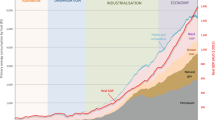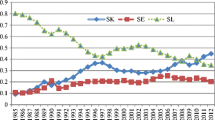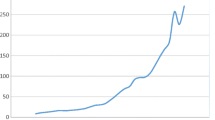Abstract
Information and communication technology (ICT) has been ascribed a crucial role for raising resource and energy efficiency and thereby contributing to environmental abatement. We investigate this conjecture by providing evidence on the relationship between ICT and energy demand. Using a cross-country cross-industry panel data set covering 13 years, 10 OECD countries, and 27 industries, our results show that ICT is associated with a significant reduction in total energy demand. This relationship differs with regard to different types of energy. ICT is negatively related to the demand for non-electric energy, but is not associated with a significant change in the demand for electric energy. Quantitatively, the effect of ICT on energy demand is greater than that on labor demand. The results survive several robustness checks which allow for various forms of heterogeneity and tackle the potential endogeneity of ICT capital.

Similar content being viewed by others
Notes
The sources and methods used in the construction of the GGDC Productivity Level Database are described by Inklaar and Timmer (2008).
Using ‘gross energy use’ does not alter our results in a significant way, especially not with respect to the effects of ICT.
For a detailed description of the procedure see Online Appendix B. As an alternative we used the oil price alone as non-electric energy price proxy. This does not change our results in a notable way.
A drawback of energy price information is its low variation across industries within a given country. Across industries, within a country, there is only variation due to differences in the weighting, which stem from differences in sectoral energy mixes. However, given that energy markets are typically national in scope, using these prices should be valid.
In fact, information on two more countries, Sweden and Czech Republic as well as for three more industries, ‘electricity, gas and water’ (NACE E), ‘coke, refined petroleum and nuclear fuel’ (NACE 23) and ‘real estate activities’ (NACE 70) is available. Sweden is excluded since only very few observations were available. Czech Republic is excluded since it is the only ‘post-communist’ country showing quite different economic structures and developments. Industries E and 23 are excluded since both are energy producing sectors and thus have a completely different production structure concerning energy demand than the remaining industries. The real estate sector is excluded since its capital stock consists mainly of residential structures and thereby strongly differs from other sectors economic structure.
It also illustrates a drawback of the WIOD and IEA energy data, their unbalancedness, which is common to all internally comparable industry-level energy data sources. Breaks in time series of single energy sources result in implausibly high growth rates in some years. However, we assume that these breaks are uncorrelated to the use of ICT capital and should thereby not systematically influence our results. We checked the robustness of our results to the presence of outliers and found our results confirmed.
We acknowledge that technology may be heterogeneous with respect to time, countries and industries and that there may be additional determinants of energy demand (such as changes in regulation, trade, output composition, etc.). We consider heterogeneity and additional factors of demand in Sect. 5.2.
We here follow the literature on ICT and labor demand in transforming the capital inputs into capital intensities. This implies that \(\beta _{EY}^{*} = \beta _{EY} + \beta _{EK_{ICT}} + \beta _{EK_{N}}\).
For a detailed derivation of this elasticity see “Appendix 2”.
Additionally, estimation in first differences reduces the risk of running into spurious regression problems and eliminates potential biases from the usage of purchasing power parities which is known to be prone to measurement error. Running our estimations in levels instead of in first-differences does not change the results very much.
Excluding the price variable and replacing it by country-year dummies does not change our results much. Results are available upon request.
As an alternative, we estimate both equations separately using the LSDV estimator in an analogous way as in the case of total energy. The results are very similar to those found with the system estimation approach. Results are available upon request.
‘Computing equipment’ consists of ‘hardware’ and ‘software’.
See e.g. Voigt et al. (2014), who show that in these two countries structural change plays a much more prominent role in driving energy efficiency developments than in most other countries.
Another even more flexible approach we employed allows each country-industry combination to have its own technology parameters. This can be achieved by applying various forms of Mean Group estimators developed by Pesaran and Smith (1995) and Pesaran et al. (1999). Unfortunately, their results are only reliable for a relatively large T per panel entity. Given that T equals 13 years in our case, this kind of estimator could be biased. We employed the Mean Group estimator (MG) by using the recently introduced xtmg command in Stata (Eberhardt 2012). We used the robust option and included a time trend in each entity estimation, which proxies the effect of time fixed effects. The results can be obtained upon request. They support our baseline findings, that is, the ICT coefficient remained negative and significant. Most other coefficients, except the price coefficient, were insignificant.
See e.g. Welsch and Ochsen (2005) on the relationship between trade and energy demand. Also, within the carbon leakage debate it is discussed whether firms relocate emission or energy intensive activities to countries with lower energy prices or lower environmental regulatory standards and thereby become statistically less polluting or less energy intensive.
We are aware that the Difference-GMM estimator might be inefficient but still decided against using the more efficient System-GMM estimator developed by Arellano and Bover (1995) and Blundell and Bond (1998), since the System-GMM estimator requires additional assumptions on the initial conditions which we think are to restrictive in the case of our application.
References
Arellano M, Bond S (1991) Some tests of specification for panel data: Monte Carlo evidence and an application to employment equations. Rev Econ Stud 58(2):277–297
Arellano M, Bover O (1995) Another look at the instrumental variable estimation of error-components models. J Econ 68(1):29–51
Autor D, Katz L, Krueger A (1998) Computing inequality: have computers changed the labor market? Q J Econ 113(4):1169–1213
Berman E, Bound J, Griliches Z (1994) Changes in the demand for skilled labor within US manufacturing: evidence from the annual survey of manufactures. Q J Econ 109(2):367–397
Berndt ER, Hesse DM (1986) Measuring and assessing capacity utilization in the manufacturing sectors of nine OECD countries. Eur Econ Rev 30(5):961–989
Berndt ER, Wood D (1975) Technology, prices, and the derived demand for energy. Rev Econ Stat 57(3):259–268
Bernstein R, Madlener R (2010) Impact of disaggregated ICT capital on electricity intensity in European manufacturing. Appl Econ Lett 17(17):1691–1695
Blundell R, Bond S (1998) Initial conditions and moment restrictions in dynamic panel data models. J Econ 87(1):115–143
Brown R, Christensen L (1981) Estimating elasticities of substitution in a model of partial static equilibrium: an application to US agriculture 1947 to 1974. In: Berndt ER, Field BC (eds) Modelling and measuring natural resource substitution. MIT Press, Cambridge, Mass
Cardona M, Kretschmer T, Strobel T (2013) ICT and productivity: conclusions from the empirical literature. Inf Econ Policy 25(3):109–125
Cho Y, Lee J, Kim T-Y (2007) The impact of ICT investment and energy price on industrial electricity demand: dynamic growth model approach. Energy Policy 35(9):4730–4738
Chun H (2003) Information technology and the demand for educated workers: disentangling the impacts of adoption versus use. Rev Econ Stat 85(1):1–8
Collard F, Fève P, Portier F (2005) Electricity consumption and ICT in the French service sector. Energy Econ 27(3):541–550
Dietzenbacher E, Los B, Stehrer R, Timmer MP, de Vries G (2013) The construction of world input–output tables in the WIOD project. Econ Syst Res 25(1):71–98
Dobbelaere S, Mairesse J (2013) Panel data estimates of the production function and product and labor market imperfections. J Appl Econ 28(1):1–46
Draca M, Sadun R, Van Reenen J (2006) Productivity and ICT: a review of the evidence. CEP discussion paper
Eberhardt M (2012) Estimating panel time-series models with heterogeneous slopes. Stata J 12(1):61–71
Erdmann L, Hilty LM (2010) Scenario analysis: exploring the macroeconomic impacts of information and communication technologies on greenhouse gas emissions. J Ind Ecol 14(5):826–843
Foster N, Stehrer R, de Vries GJ (2013) Offshoring and the skill structure of labour demand. Rev World Econ 149(4):1–32
GeSI (2008) SMART 2020: enabling the low carbon economy in the information age. Technical report, A Report by The Climate Group on Behalf of the Global e-Sustainability Initiative
GeSI (2012) SMARTer 2020: The role of ICT in driving a sustainable future. Technical report, A Report by The Climate Group on Behalf of the Global e-Sustainability Initiative
Griffin JM, Gregory PR (1976) An intercountry translog model of energy substitution responses. Am Econ Rev 66(5):845–857
Hijzen A, Görg H, Hine RC (2005) International outsourcing and the skill structure of labour demand in the United Kingdom. Econ J 115(506):860–878
Inklaar R, Timmer MP (2008) GGDC productivity level database: international comparisons of output, inputs and productivity at the industry level. GGDC Research Memorandum
Jorgenson DW (2001) Information technology and the US economy. Am Econ Rev 91(1):1–32
Kratena K (2007) Technical change, investment and energy intensity. Econ Syst Res 19(3):295–314
Ma H, Oxley L, Gibson J, Kim B (2008) China’s energy economy: technical change, factor demand and interfactor/interfuel substitution. Energy Econ 30(5):2167–2183
Machin S, Van Reenen J (1998) Technology and changes in skill structure: evidence from seven OECD countries. Q J Econ 113(4):1215–1244
Melville NP (2010) Information systems innovation for environmental sustainability. MIS Q 34(1):1–21
Michaels G, Natraj A, Van Reenen J (2014) Has ICT polarized skill demand? Evidence from eleven countries over 25 years. Rev Econ Stat 96(1):60–77
OECD (2010) Greener and smarter: ICTs, the environment and climate change. Technical report, OECD Publishing
O’Mahony M, Robinson C, Vecchi M (2008) The impact of ICT on the demand for skilled labour: a cross-country comparison. J Labor Econ 15(6):1435–1450
O’Mahony M, Timmer MP (2009) Output, input and productivity measures at the industry level: The EU KLEMS database. Econ J 119(538):374–403
Pesaran MH, Shin Y, Smith RP (1999) Pooled mean group estimation of dynamic heterogeneous panels. J Am Stat Assoc 94(446):621–634
Pesaran MH, Smith R (1995) Estimating long-run relationships from dynamic heterogeneous panels. J Econ 68(1):79–113
Pindyck RS (1979) Interfuel substitution and the industrial demand for energy: an international comparison. Rev Econ Stat 61(2):169–179
Sadorsky P (2012) Information communication technology and electricity consumption in emerging economies. Energy Policy 43:130–136
Stiroh KJ (2002) Information technology and the US productivity revival: What do the industry data say? Am Econ Rev 92(5):1559–1576
Stiroh KJ (2005) Reassessing the impact of IT in the production function: a meta-analysis and sensitivity tests. Annales d’Economie et de Statistique 78:529–561
Sue Wing I (2008) Explaining the declining energy intensity of the US economy. Resour Energy Econ 30(1):21–49
Takase K, Murota Y (2004) The impact of IT investment on energy: Japan and US comparison in 2010. Energy Policy 32(11):1291–1301
Timmer MP (2012) The World input–output database (WIOD): contents, sources and methods. WIOD discussion paper
Van der Werf E (2008) Production functions for climate policy modeling: an empirical analysis. Energy Econ 30(6):2964–2979
Voigt S, De Cian E, Schymura M, Verdolini E (2014) Energy intensity developments in 40 major economies: structural change or technology improvement? Energy Econ 41:47–62
Welsch H, Ochsen C (2005) The determinants of aggregate energy use in West Germany: factor substitution, technological change, and trade. Energy Econ 27(1):93–111
Author information
Authors and Affiliations
Corresponding author
Additional information
We thank Irene Bertschek, Steve Bond, Grazia Cecere, Elisa Duran, Daniel Erdsiek, Nikolas Georgantzis, Thomas Niebel, Mary O’Mahony, Marianne Saam, David Stern, Thomas Triebs, Michael Ward and two anonymous referees for their valuable comments. We also benefited from discussions with participants of the Mannheim Energy Conference 2013, the IIIrd Munich ICT Conference 2013, the 12th ZEW ICT Conference 2014, the 5th WCERE 2014 and the seminars at ZEW. Also we would like to thank James Binfield and Liana Platon for very helpful research assistance. For the authors’ other projects please refer to http://www.zew.de and to http://www.uni-oldenburg.de/fk2/.
Electronic supplementary material
Below is the link to the electronic supplementary material.
Appendix
Appendix
1.1 Appendix 1
1.2 Appendix 2
Based on the parameters of the cost share equations one can derive corresponding factor demand elasticities. Following the approach used by Welsch and Ochsen (2005) or Kratena (2007), one can make use of the fact that factor demand \(j\) is equal to \((\frac{VC}{P_{j}})S_{j}\) and derive the elasticity of factor demand with respect to a change in the quasi-fixed ICT capital input \(\epsilon _{jK_{ICT}}\):
Assuming exogenous prices (which implies \(\frac{\partial \ln P_{j}}{\partial \ln K_{ICT}}=0\)) and using the parameters of the cost share equation, the previous equation equals:
where \(-\frac{\partial VC}{\partial K_{ICT}}\) represents the potential reduction in variable costs through increasing ICT capital by one unit and holding output, variable input prices, and the remaining fixed inputs constant and can be denoted as the shadow value of fixed ICT capital (\(R_{K_{ICT}}\)). Either one assumes that this reduction is negligible and assumes \(-\frac{\partial VC}{\partial K_{ICT}}=0\) (see e.g. Hijzen et al. 2005 or Foster et al. 2013) or one takes this reduction into account. If one takes this reduction into account, the elasticity equals:
Since \(\frac{R_{K_{ICT}}K_{ICT}}{VC}\) and \(S_{j}\) are larger than zero by definition, \(\beta _{jK_{ICT}} < 0\) is a sufficient condition for \(\epsilon _{jK_{ICT}}\) being negative. Thus, \(\beta _{jK_{ICT}}<0\) implies not only a negative impact on the respective factor cost share (or on the relative demand for the respective factor) but, given output, also on the (absolute) demand for this factor. Following Berndt and Hesse (1986) or Kratena (2007), one can additionally assume that the ex post rate of return for capital equals the shadow price of capital input. Information on the ex post rate of return is typically available in the data. Combining it with the estimated \(\beta _{K_{ICT}}\) coefficient, the observed values of the factor cost shares, the capital input quantities and variable costs, then allows to compute the respective elasticities. They equal:
where \(S_{K_{ICT}} = \frac{P_{K_{ICT}}K_{ICT}}{VC}\). This elasticity of demand for factor \(j\) with respect to ICT capital describes by how much the respective demand for factor \(j\) changes if ICT capital increases by 1 %, holding output, the remaining fixed inputs and factor prices constant. Holding output constant implies that this elasticity is also equal to the elasticity describing the impact on the factor intensity (\(j/Y\)) and equal to the elasticity describing the impact on the factor productivity (\(Y/j\)) multiplied by minus one:
These elasticities hold for all variable input demands \(j\), that is, in our case, for labor and energy, or labor, electric and non-electric energy.
Rights and permissions
About this article
Cite this article
Schulte, P., Welsch, H. & Rexhäuser, S. ICT and the Demand for Energy: Evidence from OECD Countries. Environ Resource Econ 63, 119–146 (2016). https://doi.org/10.1007/s10640-014-9844-2
Accepted:
Published:
Issue Date:
DOI: https://doi.org/10.1007/s10640-014-9844-2




